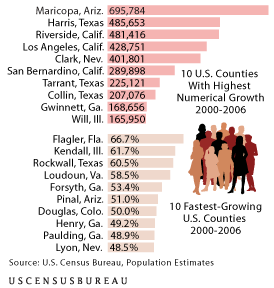
RELEASED: 12:01 A.M. EDT, THURSDAY, MARCH 22, 2007
- Robert Bernstein
- Public Information Office
- (301) 763-3030/763-3762 (fax)
- (301) 457-1037 (TDD)
- e-mail: <pio@census.gov>
- CB07-42
- Detailed tables
- State contacts
Arizona's Maricopa Leads Counties in Population
Growth Since Census 2000
Maricopa County, Ariz., gained 696,000 residents between 2000 and 2006, the largest numerical increase of the nation’s 3,141 counties, according to estimates released today by the U.S. Census Bureau.
This increase surpasses the total population of all but 15 U.S. cities. Maricopa County, which includes Phoenix, has 3.8 million residents, making it the nation’s fourth largest county.
“The dramatic increase in Maricopa County’s population is the main reason Arizona became the nation’s fastest-growing state between 2005 and 2006,” said Census Bureau Director Louis Kincannon, referring to the state population estimates released last December. “Maricopa’s growth has been remarkable, adding nearly 3 million residents since the 1970 census.”
Harris County, Texas, had the second largest numeric increase between 2000 and 2006, at 486,000, and totaled 3.9 million. Riverside, Calif. (481,000); Los Angeles (429,000); and Clark, Nev. (402,000) rounded out the top five county gainers. (See Table 1.)
Among the 20 fastest-growing counties from 2000 to 2006, 13 were in the South, four in the West and three in the Midwest.
Among the 10 counties that added the largest number of residents between 2000 and 2006, three were in Texas (Harris, Tarrant and Collin), three in California (Riverside, Los Angeles and San Bernardino), one in Georgia (Gwinnett) and one in Illinois (Will). Among the 20 counties with the largest numeric gains, 19 were in the South or West.
Los Angeles continued to be the most populous county in the nation with 9.9 million residents on July 1, 2006, followed by Cook, Ill. (5.3 million); Harris, Texas (3.9 million); and Maricopa (3.8 million). (See Table 2.)
Of those counties or county equivalents that experienced declining populations, Orleans Parish in Louisiana, which was hard-hit by Hurricane Katrina, had the largest population loss during the six-year period: 261,000. Orleans was followed by Wayne County, Mich., which lost 89,000 residents, and Cook County, Ill., with a population decline of 88,000. In 2006, Orleans Parish totaled 223,000 residents, while the population in Wayne and Cook declined to 2 million and 5.3 million, respectively.
Florida’s Flagler, along the Atlantic Coast between Daytona Beach and Jacksonville, was the nation’s fastest-growing county since Census 2000 with a 66.7 percent population increase from 2000 to 2006. The number of Flagler residents has reached 83,000.
Kendall, Ill. (61.7 percent), and Rockwall, Texas (60.5 percent), were the second and third fastest-growing counties. Three of the 10 fastest-growing counties between 2000 and 2006 were in the Atlanta-Sandy Springs-Marietta, Ga., metropolitan area: Forsyth, ranking fifth with 53.4 percent growth; Henry, ranking eighth at 49.2 percent; and Paulding, ninth at 48.9 percent. (See Table 3.)
Among the 20 fastest-growing counties from 2000 to 2006, 13 were in the South, four in the West and three in the Midwest.
Note: Pertains to counties with 10,000 or more population as of July 1, 2006.
There were 10 counties that lost at least 10 percent of their population between 2000 and 2006. Half of them are in Louisiana, led by St. Bernard Parish (-76.9 percent) and Orleans Parish (-53.9 percent).
Among Puerto Rico municipios, Toa Alta had the greatest numerical change, adding 14,000 residents between 2000 and 2006 to reach 78,000. Florida municipio experienced the highest rate of growth, with its population climbing 22.9 percent to 15,000. San Juan, with 427,000 residents in 2006, was the most populous municipio. (See Table 4.)
Other Highlights: Change from 2005-2006
Top numerical gainers
- Half the counties among the top 10 numeric gainers between 2005 and 2006 were in Texas: Harris, Tarrant, Bexar, Collin and Dallas. Maricopa, however, ranked first, adding 130,000 residents.
- Also making the list of the top 10 numeric gainers from 2005 and 2006 were the counties of Riverside, Calif.; Clark, Nev.; Wake, N.C.; and San Bernardino, Calif.
- Toa Alta was the highest numeric gainer among Puerto Rico municipios, adding 2,292 residents over the period.
Fastest-growing/declining counties with populations over 10,000
- Chattahoochee County, Ga. (home of Fort Benning), grew by 13.2 percent between 2005 and 2006, making it the fastest-growing county over the period. Joining Chattahoochee among the top 10 were Pinal, Ariz.; Kendall, Ill.; Rockwall, Texas; Flagler, Fla.; Pearl River, Miss.; Lyon, Nev.; Paulding, Ga.; Ascension Parish, La.; and Sumter, Fla.
- Georgia had a nation-leading 14 counties among the 100 fastest-growing counties. Texas followed with 13, and Florida had 12.
- Overall, 14 of the 20 fastest-growing counties between 2005 and 2006 were in the South, five in the West and one in the Midwest.
- Eight of the 10 counties with the fastest rate of population decline between 2005 and 2006 were in Louisiana or Mississippi.
- Puerto Rico’s fastest-growing municipio was Florida, with a population increase of 3.1 percent from 2005 to 2006.
The Census Bureau’s Internet tables show July 1 population estimates for 2000 through 2006, as well as the April 1, 2000, census counts. Also included are rankings and estimates of components of population change (births, deaths, net internal migration and net international migration) for all counties.
-X-
The county and municipio population estimates are calculated using administrative records to estimate components of population change, such as births, deaths, internal and international migration. The estimates reflect changes to the Census 2000 population resulting from legal boundary updates as of Jan. 1 of the estimates year, other geographic program changes and Count Question Resolution (CQR) actions. (The CQR Program was an administrative review program that handled external challenges to particular official Census 2000 counts.)
